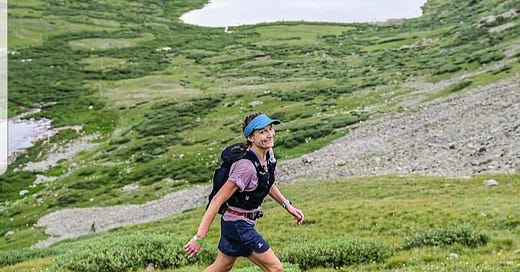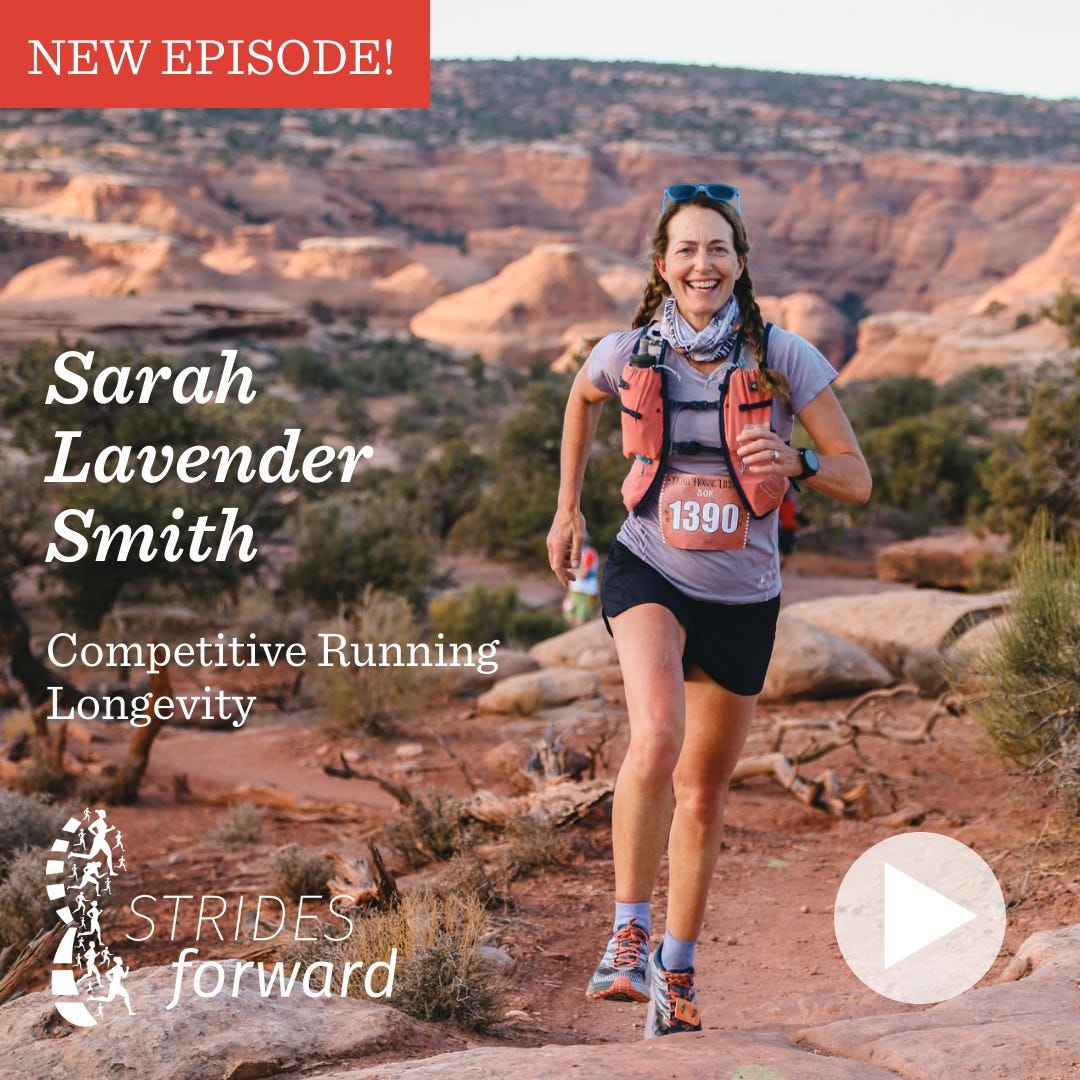From Life-Changing Pain to 100-mile Champ
A Conversation with Colorado ultrarunning coach Salynda Heinl
Hello! Those of you who follow this newsletter know that I occasionally spotlight a notable Colorado runner whom I find intriguing and inspiring. This is one of those posts. Paid subscribers will get a chance to talk to the woman profiled below, Salynda Heinl, at our monthly online meetup this Sunday afternoon, April 10, at 4:30pm Mountain. If you’d like to receive bonus posts and gain access to the monthly Zoom chat, please subscribe at the supporter level.
Last July, in preparation for the High Lonesome 100, I studied the field of competitors and made predictions about who’d be chasing whom.
I figured Western States champ Kaci Lickteig would take the lead, unless Cocodona 250 and Bigs Backyard winner Maggie Guterl had her best day. Or maybe the prior High Lonesome champ, Silke Koester, would win again against these better-known names.
Imagine my surprise on an out-and-back portion of the course, ascending a summit over 12,000 feet high around mile 28, when a dark-haired woman I didn’t recognize passed me on her way back in this two-way traffic. She was several miles ahead of me, way ahead of any other women in the field, and close behind the male front runners.
She went by so fast that I didn’t get a clear look. I had no idea who she was, and I thought she might “flame out” later in the race.

But, no. This woman I’d never heard of, Salynda Heinl of Confier (a town in the mountains west of Denver), never lost her commanding lead. She won the race 1 hour, 34 minutes ahead of runner-up Kaci and set a female course record in 25:06, and placed 7th overall.
I checked Salynda’s Instagram after the race and discovered a lot of pics of kids and beautiful mountains, and not many followers to her account. She’s 37 and the mom of two girls and a boy with earthy names—Indyka, 13; Sage, 10; and Isla is 7. She struck me as someone down-to-earth who’s likely too busy or too modest, or maybe both, to care much about social media.
My curiosity about Salynda revved up again two weekends ago, when she won the Behind the Rocks 50M in Moab. Her Ultrasignup reveals earlier wins at Quad Rock 50, San Juan Solstice 50, a string of impressive performances at the Pikes Peak Marathon (including a win in 2007, early in her trail-running career), and several top-10 finishes in the competitive “Hare” division of Run Rabbit Run 100.
I’m always interested in talented runners who come onto the scene and accomplish impressive wins and other feats quietly, with little to no hype. Realizing that she and I will cross paths again at this July’s High Lonesome 100, I reached out to Salynda to learn more about her, her training, and her coaching.
I was not expecting to hear a story of immense loss and resilience, which makes me admire her even more.
A Colorado native, Salynda was born in Denver and grew up in the suburb of Arvada. She credits a small public school for introducing her to backpacking trips and outdoor rec, which led to running. “I found my passion for the outdoors as well as my knack for endurance activities and mountain climbing and began to run for fun mostly, to get in shape for other adventures,” she says.
I sent Salynda questions for a Q&A, and her answer to this one made me wonder what had happened to her. I asked:
A decade ago, in 2012, you made the leap from Pikes Peak Marathon to Run Rabbit Run 100. That’s a pretty big leap! And you finished 4th in the Hares with a sub-30 time. Did you have a coach at that time? How did you go from PPM to RRR?
She answered: “Yes, it was a big leap! No, I did not have a coach, just a love and need to spend a lot of time running through the mountains. I was signed up for the 50-mile, but that was a year where I got more focused on training. I had a tragedy in my family with someone very close and needed a healthy outlet to cope. As the summer went on, I felt more drawn to the adventure of the 100-mile and finally went for it.”
I wondered, what tragedy? I also puzzled over her answer to another question. I asked how long she and her husband Ryan had been married, and she replied five years.
I asked, Does this mean Ryan is your second husband, and did you go through a tough transition earlier? Here’s her answer, slightly edited for length:
Salynda: “My first husband, Chris, who was the father of my two oldest children, died in an avalanche while skiing. My son Sage was 7 weeks old and daughter Indyka was 3. This explains the mountain-running journey I took that ended me at Run Rabbit Run 2012.
“It was the worst pain imaginable, forever life-changing pain. I didn't know that life could be so painful, scary, and hard.
“My life was beautiful and on the best track anyone could ask for—happily married, two beautiful children, just bought our first home. Chris was one of the most wonderful people I have ever met and will ever meet. He was absolutely hilarious, kind, gentle-natured, and fun. His life ending so young was such a tragedy.
“Then everything changed for me. I'm thankful for my love of nature and running because it offered me a healthy outlet and coping mechanism. I'm lucky that my dad was such an involved and loving grandfather (my mom passed less than a year prior) and my best friend was so close to my kids. They helped me get the time I needed to run, where I did my grieving. They were like angels along with so many other wonderful, kind, generous people who lifted me up and supported me.
“Like I never knew pain could be so immense, I never knew kindness and generosity existed like that.
“Ryan and I re-connected. We were friends in college and began to hang out, exclusively as friends. He loved climbing mountains, trail running, and the outdoors, and he became my best adventure buddy. He was very sensitive and respectful of my situation. After time we gradually realized that our feelings were more than friends. He didn't just fall in love with me but with my children, and there would not have been a relationship if that wasn't the case.
“We dated seriously for a couple years and had Isla before getting married. Untraditional, yes, but nothing short of magical! … We have settled into a normal and what I consider very happy life, something I could not have imagined when the tragedy happened.
“I can't tell you how amazing normal feels when you have experienced something so hard.
“To have a second chance at genuinely loving is my greatest blessing. For anyone wondering, your love doesn't change for your first spouse, nor does it impact the love for your second. My grandmother said, ‘your heart just gets bigger.’ Our capacity to love is infinite when we allow it.
“Like a natural disaster, there were some long-term effects. I struggled with PTSD at some capacity—I didn't understand why I had random bouts of depression. ... I share this hoping my story can help someone else, and to help end mental health stigma. …
“Running was instrumental in my ability to cope and be the mother my children needed me to be. It is not a replacement for therapy or mental health treatment, but it is a simple, healthy outlet and without it, I don't know I would have been as resilient.”
Well, that pretty much blew me away. It reminds me that you never know what some people may be going through or have been through.
Training, Racing, and Coaching
Two years ago, Salynda teamed up with past UltraRunner of the Year Michele Yates of Rugged Running to develop a coaching practice. Previously, she had studied biology and environmental science at Western State Colorado University. More recently, she earned her UESCA coaching certification. I asked why she partnered with Michele.
Salynda: “After Run Rabbit Run 2019, I decided I wanted to get more serious about running. I was also having a dilemma with what I wanted to do for work, with my youngest starting school. I wanted something flexible so I could still get my kids off to school, be home for them after school, volunteer and be active in their lives.
“Michele is the queen of Run Rabbit Run 100 [having won it three times], and I had a ton of admiration and respect for her. Also, small world, Michele also lives in Conifer, and our daughters are the same age and now are best friends. I browsed the Rugged Running website and reached out about coaching for myself and an assistant coaching position she was offering. We clicked right away … Michele simultaneously coached me as an athlete and mentored me as a coach. With her immense knowledge and background, I learned (and continue to learn so much) from her and have continued my own coaching education. … I have since been promoted to head coach.”
It looks like you got hooked on certain races (Pikes Peak Marathon, Run Rabbit Run, San Juan Solstice 50) and stuck with them. You also, in years past, didn’t race much leading up to your annual 100-mile race. Why didn’t you — what were your other priorities?
Salynda: “A lot of my running the same courses has come from the logistical simplicity of racing somewhat close to home, and certain events just become part of your heart. I also often find a desire to improve on the given course. The answer to less racing early on is definitely rooted in my priorities being elsewhere.
“I was inhibited by self-imposed mom guilt and had an existential internal battle with feeling selfish. I also lacked confidence and self-belief. I let too much of my identity fall in motherhood and lost myself a bit. But, clearly, a part of me held on. Looking back, I was always holding back a little on going all in on my training and racing because of this.
“I have grown, and so have my kids into school age. Michele [Yates]'s mentorship in self-care and confidence-building helped me immensely as well. I am also finding that my coaching fuels my purpose in training. I think of myself as a live science experiment to test things for the athletes I work for; I also gain purpose from knowing that I am inspiring and helping them. I also realize that I’m showing my kids that it is good to have a passion and to live a full inspired life.”
This will be the first year you do two 100s pretty close together, eight weeks apart: High Lonesome and Run Rabbit Run. Why are you taking on that challenge, and are you nervous about being able to excel both? Is one your “A” race more than the other?
Salynda: “They are so close! I tried to do both last year and dropped from RRR really early ... I gave so much to High Lonesome last year, both training and in the race. I admittedly overtrained in between events because I didn't trust myself—I was so worried I wouldn't be ready that I did too much. I started RRR on an empty tank and didn't have the mental or physical energy I needed. It was a huge learning experience…
“I keep going back to RRR because I still feel I have never run to my true potential out there. I have always run with something holding me back. …
“I wasn't sure if I was going to do High Lonesome again this year, but it has become one of those special events in my heart now. Plus, my absolute favorite place to be and train is in the alpine. Training for an event like High Lonesome, I can immerse my peak training in my favorite ecosystem.
“Great question about which will be my ‘A’ race. I am still establishing that. I think to be successful in both, I need to treat them as a whole, not independently. That said, with High Lonesome being first, it will be tricky to save enough for RRR. I would like to try and improve my time in both races and think that is possible even doing the double.”
Life Balance
How do you fit in your training and coaching while being a mom to three?
Salynda: “This is an important question for any family looking to balance training, career, and family. My husband works long hours, has a long commute, and sometimes travels for work. So, I do assume a larger amount of the home and childcare responsibility. I choose that role, and it works for our family. There isn't an unequal distribution of power or anything. My husband is active, involved, present, and supportive. … For both of us and our family to be successful we have to:
communicate
organize
plan (far ahead)
“For example: I organize my training schedule and communicate my key training blocks, runs, and races with my husband. He does the same with his needs and obligations. We work together, respect each other and are an awesome team!”
To avoid becoming stretched too thin, we sometimes need to give up or say no to things such as hobbies or part-time jobs or volunteer service. Have you given anything up to manage your current commitments to coaching, training, and parenting?
Salynda: “This is probably my biggest downfall. I get so excited about so many things and tend to take on too much and have learned sometimes the hard way about my limits.
“I was working as a para [a paraprofessional who works one on one with students] at my kids' elementary school for a little over half the school year and needed to make the choice to step back from it or coaching. They were amazing and moved me to a sub so I can still be a part of the school community and help, but not be too overextended. I still volunteer to lead my youngest daughter's Destination Imagination team and used to lead Girl Scouts for years—I stepped back from Scouts and delegated to another mom. I make other sacrifices as well. I am way behind on home maintenance projects, lack any kind of fashion, and miss out on certain social things to prioritize training. But I'm happy with that all right now.”
When I was your age, when I also was a busy mom raising school-aged kids, I got increasingly serious about ultrarunning as a writer covering the sport, a podcast co-host, and I started my coaching business. Suddenly, my sport and hobby became my career. This alternately felt motivating and stressful, and I became more concerned about my reputation and performance. Do you feel like you’re going “all in” now with ultrarunning and coaching, and if so, how does that feel? What are the benefits and drawbacks?
Salynda: “Everything you said is totally relatable. Especially the paradox of it being motivating/stressful. I find balance by trying to unplug when I do run, and work on being as present as possible with my effort, body biomechanics, and surroundings. …
“I worry about external pressure to perform but try to keep it in context that most of that is pressure I put on myself. … I didn't base my love of this sport on external validation, and I know that if I want to continue, I have to be internally motivated for the right reasons. I won't be at the front of the pack forever, but I don't want that to ruin my love of the sport. So I try to fight those battles and stay down to earth and grounded in my personal ‘why.’”
Do you see any 200s or multiday challenges (such as stage races and/or long FKT attempts) in your future?
Salynda: “I definitely would like to do any and all of the above, especially as my kids grow and become more independent. I have been joking (not so much) that I will do a 200 when I turn 40. I have one FKT that I ran in 2020, the Lost Creek Wilderness South loop, and I really enjoyed the logistical challenges it required; it took strategy like a game or puzzle. If I were dreaming about something right now, Nolan's would be at the top of my list. I have a lot to learn before attempting something like that. However, that would be an exciting direction to experiment with.”
Thank you so much, Salynda, for sharing your ultrarunning journey and personal backstory with me.
Salynda will be racing a month from now at the May 6 Quad Rock 50M in Fort Collins, leading up to the July 22 High Lonesome 100 and September 16 Run Rabbit Run 100. You can learn more about her coaching here. And don’t forget, you can chat with Salynda and me about training and life on this Sunday afternoon’s Zoom if you subscribe at the supporter level.
Looking for a podcast for your next long run or drive? Strides Forward released this interview with me, in which I talk about my background, ultrarunning, family, and life transitions. The interviewer, Cherie Turner, did an artful job of editing out her questions and tightening up my rambling so the talk sounds like a story. Listen closely and you’ll hear a line by the one and only Courtney Dauwalter!









